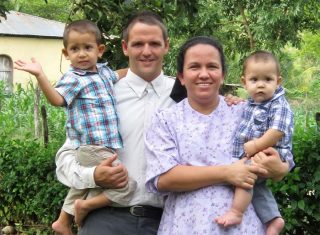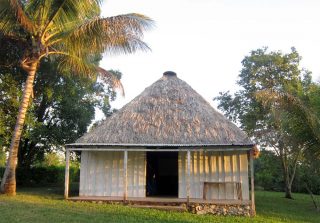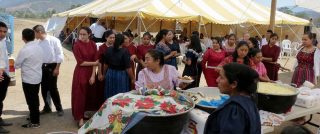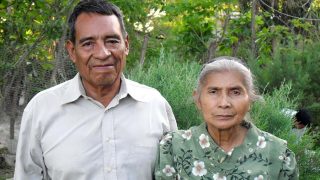- Daniel and Dora Eby give leadership to the small congregation in Santa Rosita.
- The thatch-roofed chapel in Santa Rosita.
Santa Rosita
This is a continued report. You can read the previous installment here.
There are dangers wherever you live. In the remote outpost of Santa Rosita, Guatemala, Ashley Beck was bitten by a snake on her way to attend a baby’s wake. She felt fine, but as a precaution, Jeff and Crystal Yoder drove her four hours to a private hospital in Santa Elena. Unfortunately, she reacted more to the antivenom than to the snake bite! Happily she lived to tell the tale.
Once a pregnant girl from town began having continuous seizures, endangering both her and her baby’s life. Once more an emergency trip to Santa Elena was made, and both survived. These are the times when a missionary with a truck is a real asset.
After a year of being closed, the clinic reopened in 2006. Micaela, a native nurse from Southern Guatemala, came to help Ashley but only stayed for a few months. Yalonda Miller then joined the team in July 2007; over time she became the pharmacist. Breakins and robberies happened both at the clinic and the house throughout the years, usually done in such a way that the items or money weren’t obviously missing at first.
In October of 2008 the San Pedro River became flooded from rain storms throughout Petén. The Yoder family and the VSers watched the river slowly but surely creep closer to the house until they were forced to move things to the second story and relocate to the church building. Locals related that fifteen years earlier the river had risen even higher. It took about two weeks before the water went down enough for them to move home.
The end of 2008 found the El Chal nurses helping in Santa Rosita once more. From October 2008 to February 2010 Kristina Good, Elisabeth Mejia, and Dorcas Miller began to fill in for Ashley, who was ready for a break. Dorcas Miller was asked to take Ashley’s place, and in March of 2010 she joined the Santa Rosita team.
And the church grew. Maria, a single mother of five young sons and a teenage daughter, began attending. She became a Christian and was baptized. Marcolfa, who had attended since the early days, became a member in 2007. In 2010, a young girl named Teresa León became a Christian and was baptized. Soon after, her stepfather Juan had a drunken fight with another man who threatened his life. This made Juan think hard, and in February of 2011 he became a Christian. A short time later he and Teresa’s mother Iliana were married. In December of 2012 Juan León was baptized along with Blanca Castillo, Yovani and Ester’s daughter. Amarilis, Marcolfa’s daughter, followed her mother’s steps and decided to become a Christian that same year after counting the cost for a long time.
But all was not well. Within a relatively short time, Jorge Rodriguez, who had been an active member for many years, stopped coming to services. Maria withdrew her membership. Then Yovani was excommunicated for an unrepentant spirit about an ongoing sin.
Spiritual work continued: cottage meetings were occasionally held, special meetings were planned, and the neighbors were invited. The seeds of faith continued to be sown each week; would there be growth?
Three different VS boys helped Jeff with the church work over the years – Eldon Yoder, Nathan Yoder, and Wendell Diem.
While selling Bibles, fishing supplies, and baked goods in Naranjo to make contacts and to help meet expenses, Jeff saw the booming town as more receptive to the Gospel than Santa Rosita. So in December of 2010 Jeff and Crystal left the big house in Santa Rosita and moved to Naranjo along with two VS boys and Melody Showalter. Steve and Valerie Diefenbacher moved into the Santa Rosita house and added two VS girls to their family of four children. They served as houseparents for the clinic girls and as church support until their departure in October 2012. The Naranjo team traveled to Santa Rosita for church services mostly by boat, even in the rain.
Since Santa Rosita was well off the main road, it was hard for many people to take advantage of the clinic’s services. And with the general improvement of the road, the river was being used less and less for travel to Naranjo. Patients rarely arrived by river anymore. So the decision was made to move the clinic to the central hub of the area, Naranjo. The clinic and its staff moved to Naranjo the end of 2011.
In 2012, Janet Meyers arrived to help staff the expanded clinic. Melody went from helping Crystal at home to being the clinic secretary. Wendell moved back to Santa Rosita with the Diefenbachers for a few months and lived in the old clinic. A separate girls’ house was found for the clinic staff in the spring of 2012.
After much prayer Jeff and Crystal reluctantly decided to terminate their time in Guatemala because of the health of their three-year-old son. So they left Guatemala in January 2014, leaving the newly arrived Daniel and Dora Eby in charge of the church. Earl and Hettie Barnhart returned to Guatemala and lived in Naranjo from February to July 2014.
The clinic also experienced changes. Lauren Martin arrived in March 2014 for training before Janet left in June. Yalonda and Melody both returned to the States in November 2014. Aura Santos from Los Achiotes took Yalonda’s place in the pharmacy for one year, and Abigail Martin replaced Melody. Later Teresa León became part of the clinic team as secretary, and Abigail graduated to the pharmacy. Steve and Melissa Miller and their two daughters moved to Naranjo in August 2015 to support the clinic and to help with church work. They left in May 2016.
For a while Thursday evening services were held on the clinic porch in Naranjo. The Santa Rosita congregation would travel either by truck or boat to attend, but services were suspended after a few months. The clinic staff continued to hold a children’s class each Thursday afternoon with about fifteen children on the clinic porch. In December 2016 the difficult decision was made to close the clinic, and the work in El Naranjo was terminated. Currently Daniel and Dora live in Santa Rosita, and two VS boys are being sent to help with the needs in the church and community.
So, what happened to those early members and friends?
Carlos Lima made a recommitment in a revival meeting two years ago, but unfortunately it didn’t last. Though he knows what he should do, something holds him back. His wife Francisca has struggled with her health but still retains her faith in God.
Miguel still lives in Santa Rosita and shows up to services once or twice a year. His wife Chus died in childbirth eight years ago. She was not a professing Christian, as far as I know.
Delia moved to Mexico and is no longer a Christian.
Jorge Rodriguez married a Catholic girl and no longer lives in the Santa Rosita area.
Yovani continues to ignore his need for repentance. He sometimes shows up for special services, but makes no move towards restoration.
Maria is now Santa Rosita’s mayor. When none of the men wanted the job, she volunteered!
Current and faithful members include Ester and Blanca Castillo, Marcolfa and Amarilis Montenegro, and Juan León and his stepdaughter Teresa. Please pray that the church will remain strong in the faith and continue to grow spiritually.
Vision
Vision—what comes to your mind when you hear that word? I think of the natural ability to see. I wear glasses because my natural eyesight limits my distant vision. With glasses I can see not only what is directly in front of me but also see clearly what is off in the distance. Solomon had a few words to say about prophetic vision. “Where there is no vision, the people perish” (Proverbs 29:18).
Vision. Each of our lives have been shaped to some degree by people who had a vision for our future. Friends, mentors, coworkers, pastors, and academic teachers all impact our lives to some degree. God blessed me with parents who loved me and wanted to provide the best for me. My father provided me with tools to encourage my creativity. As Christian parents, they had a vision to teach right and wrong. Most of us will probably never fully comprehend how our lives have been impacted by the positive influences God has brought into them.
We also enjoy material benefits from those with a vision for the future. The conveniences that we enjoy, the vehicles that we drive, the appliances that we use, the technology that makes communication easy—all are the product of someone’s vision. Everyday things that we take for granted are the result of someone’s hard work. We don’t see the hard work of designing and manufacturing things that we use without a second thought. We never saw the failed attempts, the scrap heap of failed ideas. We benefit from the result of someone willing to try again after the first or fortieth failed attempt.
Jesus had a vision for His church. “I will build my church and the gates of Hades (death) will not overpower it” (Matthew 16:18 AMP). Jesus said this in the presence of His disciples who later were tasked with building the church after Jesus ascended. What happened to those men? Most were killed because of their faith and their obedience to the commands of Christ. Did it look to them like Hell was winning, that Satan was stamping out the church? Why then did Jesus make that statement? Because that was and still is the prophetic vision. Jesus knew that no matter how much it looks like the devil is prevailing, in the end the victory will be won.
Today our churches and mission programs are all bound by a common thread that goes back to that vision. Jesus said, “Go and teach all nations,” “Heal the brokenhearted,” and “Lift up the hands that hang down.” We are individuals working together to build the kingdom of God, because we have a vision for the future.
One night some years ago, I went with a friend to hunt in the jungle. It was a dark night, and our only light was from flashlights. We walked a trail for a while without finding anything. It was only when we were ready to walk back out that we realized we were lost. That night I understood just how easy it is to walk in a big circle in the jungle when one can only see the small illuminated area ahead. We knew where we wanted to go, but not how to get there. We needed to see farther than our beam of light. Our shortsighted vision that night caused us to go in circles.
Sometimes we need to focus on what is directly ahead of us to arrive at our destination. People that drive in Central American countries know that it is not only necessary to see what is happening down the road, it’s also important to look directly in front of you to avoid hitting potholes and speed bumps. Our long view determines our direction, but our short view shows which side of the road is the smoothest.
How does this relate to our missions today? First, we need to start with our own heart’s vision. Do we have a vision? Since each of us is a unique individual, we each have the capacity to translate God’s Word and its principles into daily life in our own unique manner. But just as God’s Word isn’t limited to one language, so God’s church isn’t limited to one individual’s way of thinking.
If our vision is to build God’s kingdom, then God is able to use us to accomplish His plan. I need to periodically stop and look at my own life. What am I doing? Is where I am today going to help me achieve my long-term goal? Just as a good manufacturing company will constantly upgrade and improve their line of products to better suit their industry, so we need to be willing to change or improve things that will contribute to reaching our goals. The same applies to our churches and missions. The vision is still the same, but because of a world that changes and a devil that constantly tries to take us down, the potholes in the road may be in different spots today than they were five years ago. But praise God, He never changes; the Spirit’s power is still the same, and man’s basic need is still for a Saviour!
Today the Lord is looking for men and woman willing to look up and see the fields ready for harvest—people who are willing to translate God’s Word into practical daily life. The church needs men willing to lead out and stand up for what is right. We need a vision for our youth; they will lead the church of tomorrow. We need teachers with a vision to not only teach the mind, but to touch the heart. I need a vision that the little boy who comes to my yard to play could someday grow up and love Jesus. The vision is that the hurting people I meet each day could be shown the love of God. We all need a vision. May God give us the strength to act on the vision that He gives us.
- Rubén Benito and Tiana Martin were married on February 19, 2017.
- Rubén and Tiana’s wedding reception.
Wedding in San Bartolomé
It was February 19, 2017, in San Bartolomé, Jocotenango, Quiché. The sun blazed down on the yellow tent erected on the airstrip. Babies wrapped in colorful Quiché flare, bobbling on their mother’s backs, prim and proper North Americans, and friends from all over Guatemala gathered to witness Rubén Benito and Tiana Martin’s wedding ceremony. Byron de la Rosa moderated the service, and Vernon Martin preached the message in the three most prominent languages present: Quiché, Spanish, and English. Duane Eby performed the ceremony and presented the happy couple. Under a second tent, guests enjoyed a scrumptious meal served out of huge fire-blackened kettles.
Rubén was born to José and Tiburcia Benito in San Bartolome. Tiana spent her childhood in Novillero, two hours away. The Martin children and the Benito children enjoyed frequent exchange. The Martin family then moved to the States. Tiana returned to Guatemala nine years later to help in her brother Benjamin’s home. A friendship between Rubén and Tiana ensued, and now, Rubén and Tiana have made their home in San Bartolomé. Rubén teaches school and helps out with the family business. Rubén and Tiana’s discipleship role in the local congregation will be invaluable, and they need your prayers to do it well.
- Rigoberto and Rosa lived and served in at least seven places during their years of outreach and church leadership. Rosa died in 2016; Rigoberto passed away in March.
Rigoberto Portillo Rodríguez
Nearly one month short of a year after his wife Rosa went to be with the Lord, Rigoberto also reached the end of his journey on March 14, 2017. I remember Rigoberto telling me that he had accepted the Lord seven days before his wife did in 1976 and was ordained deacon in La Sorpresa church in 1979. From there, pastoring churches and beginning new outreaches led them to serve in leadership in at least seven different outposts in Guatemala. He was also influential in the outreach to Honduras.
Since his wife’s death, Rigoberto’s health had failed considerably, making it difficult for him to walk the three kilometers to church every Sunday. He lived in his own house during this lonely time and still loved to travel. It was not uncommon to see Rigoberto show up at the mission headquarters even though he had to walk with a cane.
Rigoberto was a favorite song leader; he loved to sing. He was a strong leader and a faithful example. His presence is greatly missed in Guatemala, but being in the presence of the Lord is far better.
Download The Entire May/June Newsletter






